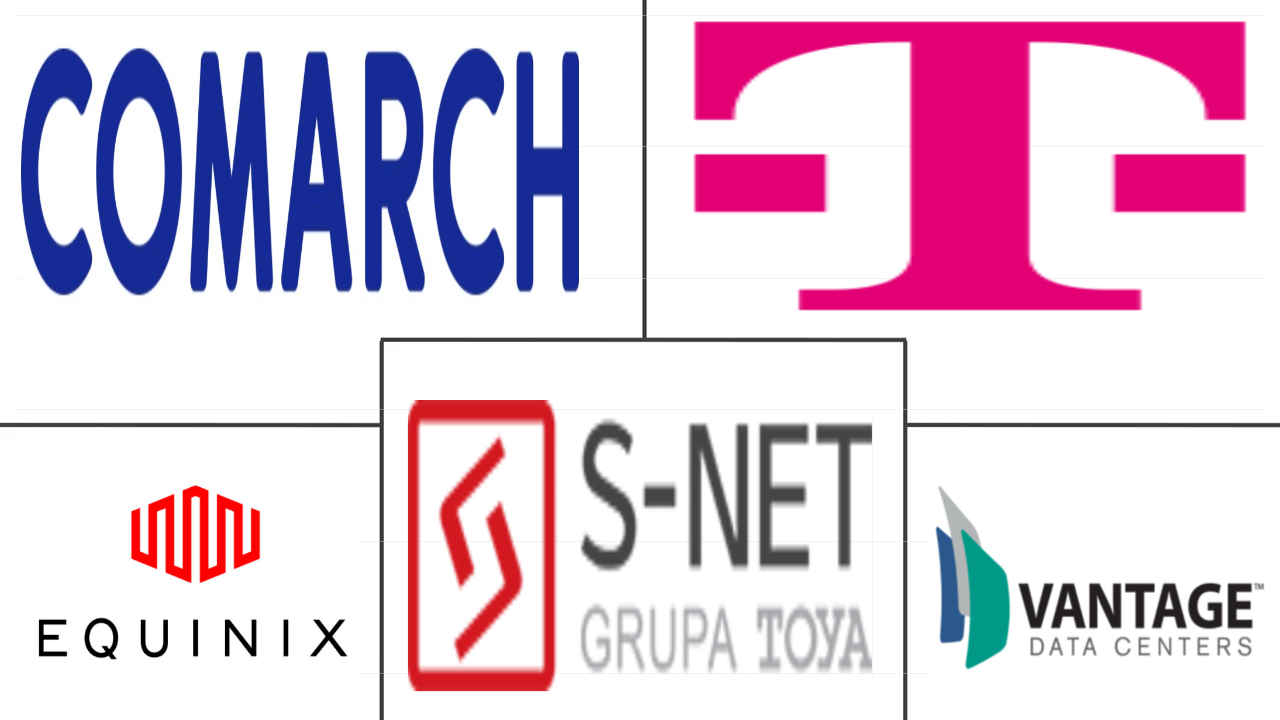Poland Data Center Market Size and Share
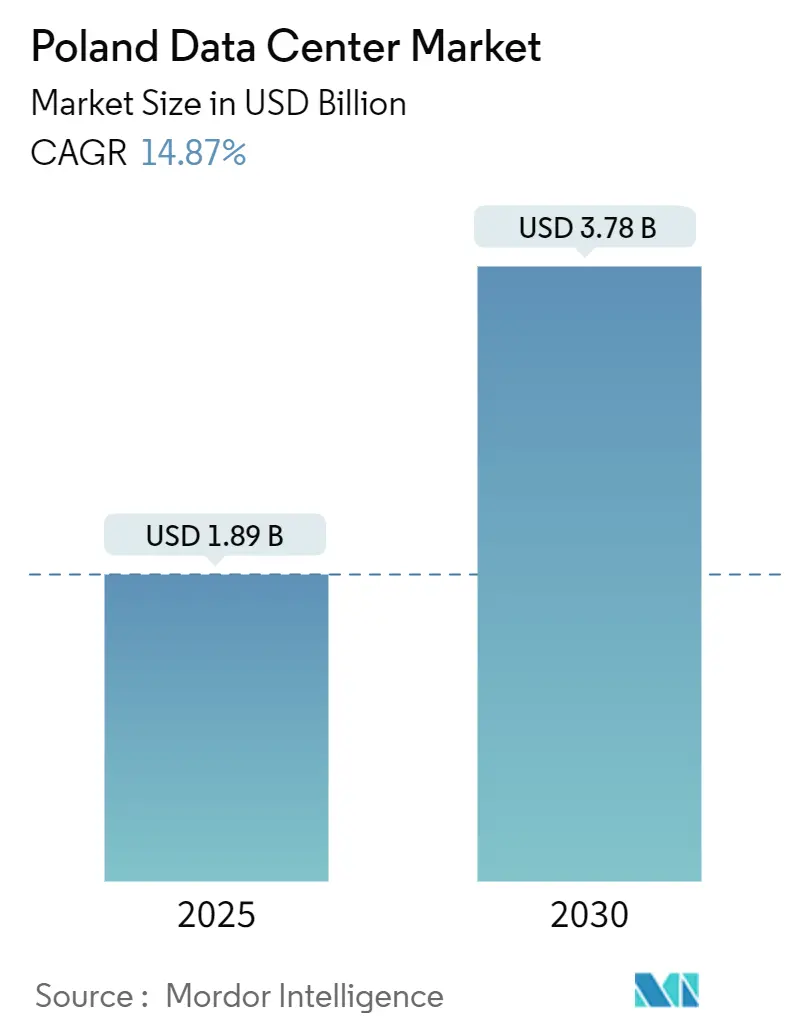
Poland Data Center Market Analysis by Mordor Intelligence
The Poland data center market size stands at USD 1.89 billion in 2025 and is projected to reach USD 3.78 billion by 2030, translating into a 14.87% CAGR. Strong hyperscale cloud investments, rapid enterprise digitalization, and a growing renewable-energy pipeline anchor the expansion of the Poland data center market. In parallel, the nation’s installed IT load capacity is forecast to rise from 660 MW in 2025 to 930 MW in 2030, a 7.34% CAGR that signals a pivot toward AI-optimized, high-density deployments rather than pure footprint growth. The market segment shares and estimates are calculated and reported in terms of MW. Scale economics favour massive campuses that attract global operators, while government incentives and cross-border fiber links amplify Poland’s positioning as Central and Eastern Europe’s preferred interconnection hub. Competitive dynamics are shifting as hyperscalers begin to outpace local providers, and regional diversification beyond Warsaw accelerates to mitigate grid constraints.[1]Chancellery of the Prime Minister, “Microsoft Invests PLN 3 Billion in a New Data Center in Poland,” GOV.PL, gov.pl
Key Report Takeaways
- By data center size, massive facilities held 62.59% of Poland's data center market share in 2024, while medium installations are projected to grow at a 7.90% CAGR through 2030.
- By tier type, Tier 4 captured an 82.53% revenue share in 2024 and is expected to advance at an 8.10% CAGR through 2030.
- By data center type, hyperscale and self-built sites accounted for 76.77% of the Poland data center market size in 2024, while edge-focused facilities posted the fastest growth rate of 7.76% CAGR.
- By end user, IT and telecom accounted for 45.74% demand in 2024; BFSI is projected to expand at an 8.00% CAGR to 2030.
- By hotspot, Warsaw controlled 69.86% of the value in 2024; however, the Rest of Poland segment is growing at an 8.50% CAGR over the forecast horizon.
Poland Data Center Market Trends and Insights
Drivers Impact Analysis
| Driver | (~) % Impact on CAGR Forecast | Geographic Relevance | Impact Timeline |
|---|---|---|---|
| Surge in hyperscale and self-build investments by global cloud service providers | +4.20% | Warsaw and Rest of Poland, with spillover to CEE region | Medium term (2-4 years) |
| Poland's rapidly-growing renewable energy pipeline enabling green data center operations | +2.80% | National, with concentration in coastal and southern regions | Long term (≥ 4 years) |
| Implementation of 5G and edge-computing use-cases by telecom operators | +2.10% | Urban centers, expanding to secondary cities | Medium term (2-4 years) |
| Government cash-grant incentives under the Polish Investment Zone scheme | +1.90% | National, with higher intensity in economically disadvantaged regions | Short term (≤ 2 years) |
| EU-funded cross-border fiber projects boosting international connectivity | +1.50% | Border regions and major interconnection hubs | Long term (≥ 4 years) |
| Under-penetrated regional hubs unlocking secondary-city demand | +1.20% | Kraków, Wrocław, Gdańsk, and other regional centers | Medium term (2-4 years) |
| Source: Mordor Intelligence | |||
Surge in Hyperscale and Self-Build Investments by Global Cloud Service Providers
Capital expenditure from hyperscalers is reshaping the Poland data center market. Microsoft’s PLN 3 billion (USD 750 million) phase-two outlay, Google’s sovereign-cloud partnership with Domestic Cloud Provider, and Amazon’s cumulative EUR 7 billion (USD 7.91 billion) commitment underscore long-term confidence in the location. New multi-building campuses multiply demand for power, cooling, and network backbones, creating a spillover effect for suppliers and contractors. Sovereignty-focused architectures draw heavily on regulated sectors such as BFSI and government agencies. In turn, the Poland data center market attracts AI and machine-learning workloads needing high-density compute, cementing the country as a regional digital hub.
Poland’s Rapidly Growing Renewable Energy Pipeline Enabling Green Data Center Operations
The share of renewables in Poland’s electricity mix reached 30% in 2024, aided by a 37% year-on-year surge in solar output.[2]Fulghum, Nicolas, “Wind and Solar Overtake EU Fossil Fuels in the First Half of 2024,” EMBER-ENERGY.ORG, ember-energy.org National targets call for 57 GW of renewable capacity by 2030, which lowers the carbon intensity of future hyperscale builds. Data center operators leverage long-term PPAs and on-site solar to hedge energy costs, while regulatory changes now let facilities install rooftop systems up to 150 kWp without permits. Beyond.pl’s Poznań campus, sourcing 100% renewable electricity at a 1.2 PUE, illustrates feasible green operations. Sustainable credentials strengthen the export appeal of the Poland data center market toward ESG-driven European enterprises.
Implementation of 5G and Edge-Computing Use Cases by Telecom Operators
Orange Polska seeks to cover more than 90% of the population with 5G by 2028 and expand fiber to 12 million households, elevating demand for edge colocation nodes. Operators such as T-Mobile Polska plan to sunset 3G and redeploy spectrum toward 5G, shortening last-mile latency. Low-latency services for autonomous mobility, industrial IoT, and AR/VR rely on micro data centers within city limits. As telecoms integrate IT services into their portfolios, they increasingly colocate AI accelerators in edge racks, diversifying the revenue mix of the Poland data center market.
Government Cash-Grant Incentives Under the Polish Investment Zone Scheme
The Polish Investment Zone offers corporate income-tax exemptions of up to 50% of qualified costs, with surcharges boosting relief to 70% for small and medium enterprises.[3]PwC, “Poland - Corporate - Tax Credits and Incentives,” PWC.COM, pwc.com Incentives align with data-center depreciation schedules that typically span 15 years, improving project IRRs. Add-ons such as the 200% R&D deduction and 50% robotization relief until 2026 further lower effective tax rates on energy-efficient equipment purchases. For investors evaluating multiple CEE locations, the scheme tilts the economics toward the Poland data center market.
Restraints Impact Analysis
| Restraint | (~) % Impact on CAGR Forecast | Geographic Relevance | Impact Timeline |
|---|---|---|---|
| Scarcity of power grid capacity in Warsaw metropolitan area | -2.80% | Warsaw metropolitan area, with secondary effects on regional development | Short term (≤ 2 years) |
| Lengthy environmental permitting for large-scale facilities | -1.90% | National, with particular impact on greenfield developments | Medium term (2-4 years) |
| Fluctuating electricity prices tied to EU-ETS carbon costs | -1.40% | National, with higher impact on coal-dependent regions | Medium term (2-4 years) |
| Limited availability of highly-skilled data-center-specific workforce | -1.10% | Urban centers, with acute shortages in specialized technical roles | Long term (≥ 4 years) |
| Source: Mordor Intelligence | |||
Scarcity of Power Grid Capacity in Warsaw Metropolitan Area
Available connection capacity in Warsaw fell 41% between 2022 and 2024, leaving only 3.8-4.4 GW for industrial users. Aging 110 kV lines and substation congestion trigger 12-24 month wait times for multi-megawatt hookups. Developers must finance on-site substations or pivot to secondary cities, prompting the Poland data center market to disperse beyond the capital.
Lengthy Environmental Permitting for Large-Scale Facilities
Projects needing environmental impact assessments face complex approvals that can stretch 12-24 months and involve multiple agencies. Facilities near Natura 2000 zones or drawing high water volumes for cooling undergo extra scrutiny, adding 2-5% to budgets. These hurdles elongate time-to-market and may deter smaller entrants from the Poland data center market.
Segment Analysis
By Data Center Size: Dominance of Massive Facilities with Rising Edge Demand
Massive sites represented 62.59% of the Poland data center market share in 2024, buoyed by hyperscale strategies that favour multi-building campuses exceeding 19,000 square meters. Atman’s WAW 3 campus illustrates this scale advantage. Despite their heft, mega sites designed for AI model training are emerging as the next frontier. Medium size data center segment accounted for the fastest CAGR of 7.90% over the forecast period 2025 to 2030.
Higher rack densities and the adoption of liquid cooling push power requirements upward, but they also unlock compute efficiencies per square meter. Operators blend centralized and edge footprints to optimize the total cost of ownership and latency. In this design, massive campuses act as regional cores, while edge pods process time-critical data at network extremities, creating a hybrid topology that reshapes investment flows in the Polish data center market.
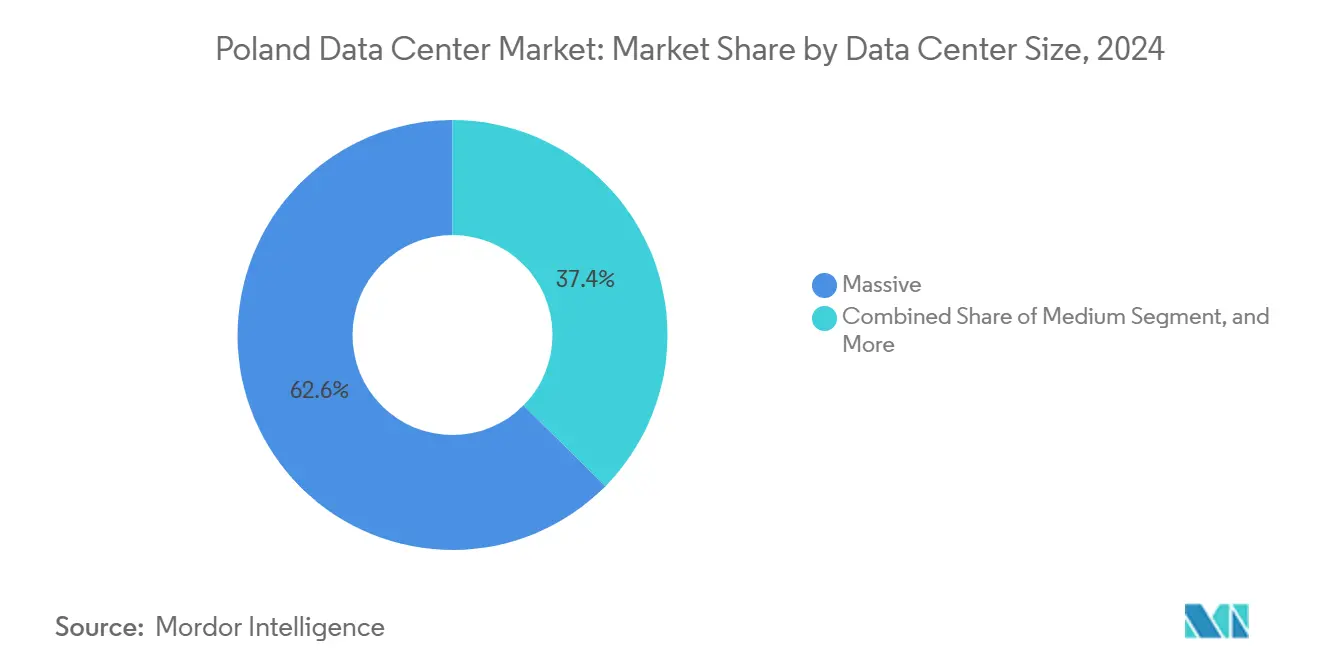
Note: Segment shares of all individual segments available upon report purchase
By Tier Type: Enterprise Reliance on Fault-Tolerant Infrastructure
Tier 4 facilities captured 82.53% of revenue in 2024 and registered the fastest 8.10% CAGR, underscoring stringent uptime mandates. BFSI, healthcare, and public-sector workloads require 99.995% availability, propelling demand for concurrently maintainable designs. Beyond.PL’s ANSI/TIA-942 Rated 4 site in Poznań pairs fault tolerance with a 1.2 PUE.
Tier 3 remains relevant for cost-sensitive enterprises, while Tier 1-2 facilities primarily serve staging environments. Ongoing EU regulations such as NIS2 tighten cyber-resilience standards, indirectly uplifting Tier 4 deployment rates. Consequently, the Poland data center market size weighted toward Tier 4 should rise steadily through 2030.
By Data Center Type: Hyperscale Outlays Shift Market Structure
Hyperscale and self-built infrastructure owned 76.77% of the value in 2024. Microsoft, Google, and Amazon now dictate design norms, favouring AI-ready power densities above 30 kW per rack. Wholesale and retail colocation still cater to enterprises needing physical control without capex burdens, and these offerings act as on-ramps to public clouds.
Edge-focused facilities post the briskest 7.76% CAGR, exploiting proximity to end users for latency-sensitive applications. Operators increasingly repurpose telco switching centers or build modular sites near 5G towers, enriching geographic diversity across the Poland data center market.
By End User: Financial Services Accelerate Infrastructure Spend
IT and telecom customers provided 45.74% of 2024 demand, mirroring aggressive network upgrades and software-defined architectures. The BFSI segment, however, exhibits the top 8.00% CAGR as digital banking, AI-driven risk models, and DORA compliance mandate local, fault-tolerant computing. These factors expand the Poland data center market size catered to fintech and incumbent banks alike.
Elsewhere, e-commerce logistics, Industry 4.0 manufacturing, and media streaming use cases push demand for mixed-density colocation suites. Government digitalization programs also persist, anchored by sovereign-cloud requirements that favor domestic hosting.
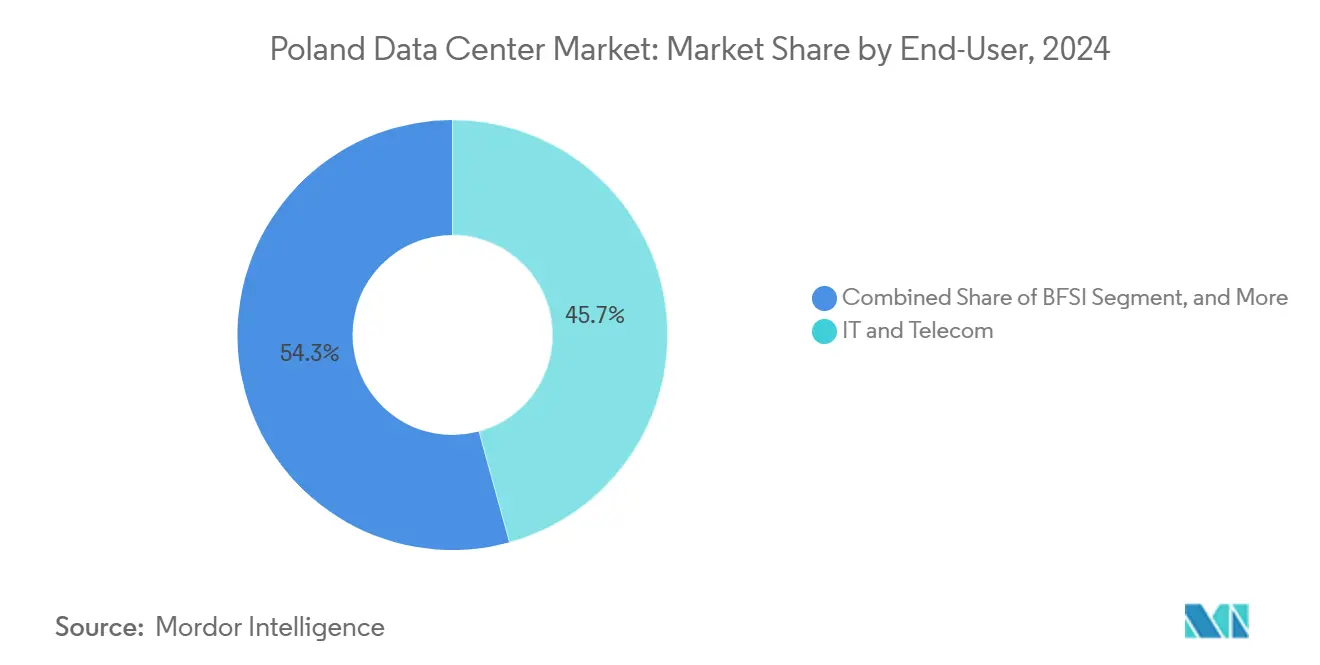
Note: Segment shares of all individual segments available upon report purchase
By Hotspot: Warsaw Dominance and Rapid Regional Diversification
Warsaw accounted for 69.86% of Poland data center market share in 2024, reflecting its concentration of international connectivity, enterprise headquarters, and skilled labor. Power-grid constraints in the capital, however, cap near-term expansion capacity, prompting operators to pre-book substations and explore adjacent suburbs for additional megawatt allocations. Rest of Poland is expanding at an 8.50% CAGR through 2030, signalling a decisive shift toward secondary metros that pair lower land costs with government tax relief under the Polish Investment Zone scheme. As a result, the Poland data center market size tied to regional hubs is expected to rise steadily, supported by robust fiber corridors that shorten round-trip latency to major European IXPs.
Regional hotspots such as Poznań, Wrocław, Kraków, and Gdańsk benefit from university talent pools, airport cargo links, and renewable-energy buildouts that bolster sustainability credentials. Beyond.pl’s 100 MW campus in Poznań demonstrates the technical maturity of these locales, achieving a PUE of 1.2 while running on 100% renewables. The Pomeranian Special Economic Zone in Gdańsk secured PLN 2.8 billion in 2024 investment pledges aimed at green energy and digital infrastructure, reinforcing momentum outside the capital. Collectively, these developments diversify the geographic footprint of the Poland data center market, mitigate single-city grid bottlenecks, and position secondary hubs to capture edge-computing and AI workloads that demand proximity to end users.
Geography Analysis
Warsaw commanded 69.86% of 2024 spending, leveraging dense fiber routes, proximity to the Warsaw-Chopin international gateway, and the largest IT talent pool. Microsoft’s Mazovia campus underscores the capital’s hyperscale magnetism. Yet grid bottlenecks spur operators to scout alternative plots around the ring road or to pursue dedicated substations, nudging some deployments outward.
Secondary metros enjoy an 8.50% CAGR as incentives and lower real-estate costs lure new builds. Poznań, Wrocław, and Kraków each host university clusters that supply engineers, while Gdańsk leverages Baltic cable landings for overseas latency gains. The Pomeranian Special Economic Zone attracted PLN 2.8 billion in 2024 commitments, reflecting regional policy success.
Coastal wind-farm pipelines and inland solar projects improve green-energy access beyond Warsaw. As EU-funded rail and road corridors shorten freight times, edge nodes in logistics hubs emerge, reinforcing a multi-polar topology across the Poland data center market.
Competitive Landscape
Top Companies in Poland Data Center Market
The Poland data center market exhibits moderate concentration. Three hyperscalers, Microsoft, Google, and Amazon, drive the majority of incremental megawatts through self-owned estates tailored for cloud and AI services. Their capital intensity raises the entry bar and accelerates technology cycles.
Specialized colocation providers such as Atman, Beyond. Pl, and Vantage Data Centers compete on connectivity density, certifications, and hybrid-cloud enablement. Atman’s USD 344 million debt package finances an expansion to more than 50,000 servers, while Beyond. Pl opened a sovereign AI factory that couples fault tolerance with 100% renewables. International newcomers, including Switch Datacenters, widen the field, signalling confidence in long-term demand.
Edge-centric opportunities draw regional telcos and energy firms that possess suburban real estate or rights-of-way. Differentiation pivots to liquid-cooling know-how, automation, and renewable integration. Compliance with EU security directives further advantages incumbents with mature governance frameworks, deepening competitive moats.[4]Jander, Mary, “Equinix Aims to Raise USD 15 Billion for AI Data Centers,” FUTURIOM.COM, futuriom.com
Poland Data Center Industry Leaders
-
Comarch SA
-
Deutsche Telekom AG (T-Mobile Poska SA)
-
Equinix Inc.
-
S-NET Sp. z.o.o (TOYA Group)
-
Vantage Data Centers LLC
- *Disclaimer: Major Players sorted in no particular order
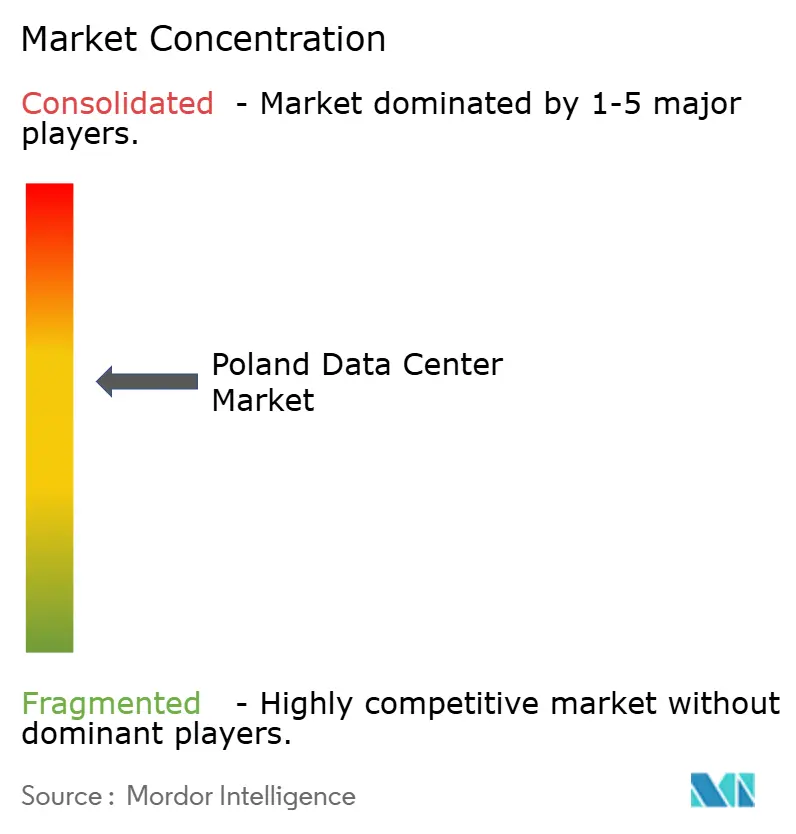
Recent Industry Developments
- May 2025: Beyond.pl launched its Sovereign AI Factory at a 100 MW campus in Poznań, aiming at data-residency-sensitive workloads.
- February 2025: Microsoft confirmed a USD 705 million allocation to expand AI and cloud infrastructure in Poland.
- January 2025: Data4 Group began building a 180 MW mega campus in Germany while retaining Warsaw as a strategic node linking Western and Eastern Europe.
- October 2024: Atman closed PLN 1.35 billion (USD 344 million) in syndicated financing to scale its WAW 3 campus.
Poland Data Center Market Report Scope
Warsaw are covered as segments by Hotspot. Large, Massive, Medium, Mega, Small are covered as segments by Data Center Size. Tier 1 and 2, Tier 3, Tier 4 are covered as segments by Tier Type. Non-Utilized, Utilized are covered as segments by Absorption.| Large |
| Massive |
| Medium |
| Mega |
| Small |
| Tier 1 and 2 |
| Tier 3 |
| Tier 4 |
| Hyperscale/Self-built | ||
| Enterprise/Edge | ||
| Colocation | Non-Utilized | |
| Utilized | Retail Colocation | |
| Wholesale Colocation | ||
| BFSI |
| IT and ITES |
| E-Commerce |
| Government |
| Manufacturing |
| Media and Entertainment |
| Telecom |
| Other End Users |
| Warsaw |
| Rest of Poland |
| By Data Center Size | Large | ||
| Massive | |||
| Medium | |||
| Mega | |||
| Small | |||
| By Tier Type | Tier 1 and 2 | ||
| Tier 3 | |||
| Tier 4 | |||
| By Data Center Type | Hyperscale/Self-built | ||
| Enterprise/Edge | |||
| Colocation | Non-Utilized | ||
| Utilized | Retail Colocation | ||
| Wholesale Colocation | |||
| By End User | BFSI | ||
| IT and ITES | |||
| E-Commerce | |||
| Government | |||
| Manufacturing | |||
| Media and Entertainment | |||
| Telecom | |||
| Other End Users | |||
| By Hotspot | Warsaw | ||
| Rest of Poland | |||
Market Definition
- IT LOAD CAPACITY - The IT load capacity or installed capacity, refers to the amount of energy consumed by servers and network equipments placed in a rack installed. It is measured in megawatt (MW).
- ABSORPTION RATE - It denotes the extend to which the data center capacity has been leased out. For instance, a 100 MW DC has leased out 75 MW, then absorption rate would be 75%. It is also referred as utilization rate and leased-out capacity.
- RAISED FLOOR SPACE - It is an elevated space build over the floor. This gap between the original floor and the elevated floor is used to accommodate wiring, cooling, and other data center equipment. This arrangement assist in having proper wiring and cooling infrastructure. It is measured in square feet (ft^2).
- DATA CENTER SIZE - Data Center Size is segmented based on the raised floor space allocated to the data center facilities. Mega DC - # of Racks must be more than 9000 or RFS (raised floor space) must be more than 225001 Sq. ft; Massive DC - # of Racks must be in between 9000 and 3001 or RFS must be in between 225000 Sq. ft and 75001 Sq. ft; Large DC - # of Racks must be in between 3000 and 801 or RFS must be in between 75000 Sq. ft and 20001 Sq. ft; Medium DC # of Racks must be in between 800 and 201 or RFS must be in between 20000 Sq. ft and 5001 Sq. ft; Small DC - # of Racks must be less than 200 or RFS must be less than 5000 Sq. ft.
- TIER TYPE - According to Uptime Institute the data centers are classified into four tiers based on the proficiencies of redundant equipment of the data center infrastructure. In this segment the data center are segmented as Tier 1,Tier 2, Tier 3 and Tier 4.
- COLOCATION TYPE - The segment is segregated into 3 categories namely Retail, Wholesale and Hyperscale Colocation service. The categorization is done based on the amount of IT load leased out to potential customers. Retail colocation service has leased capacity less than 250 kW; Wholesale colocation services has leased capacity between 251 kW and 4 MW and Hyperscale colocation services has leased capacity more than 4 MW.
- END CONSUMERS - The Data Center Market operates on a B2B basis. BFSI, Government, Cloud Operators, Media and Entertainment, E-Commerce, Telecom and Manufacturing are the major end-consumers in the market studied. The scope only includes colocation service operators catering to the increasing digitalization of the end-user industries.
| Keyword | Definition |
|---|---|
| Rack Unit | Generally referred as U or RU, it is the unit of measurement for the server unit housed in the racks in the data center. 1U is equal to 1.75 inches. |
| Rack Density | It defines the amount of power consumed by the equipment and server housed in a rack. It is measured in kilowatt (kW). This factor plays a critical role in data center design and, cooling and power planning. |
| IT Load Capacity | The IT load capacity or installed capacity, refers to the amount of energy consumed by servers and network equipment placed in a rack installed. It is measured in megawatt (MW). |
| Absorption Rate | It denotes how much of the data center capacity has been leased out. For instance, if a 100 MW DC has leased out 75 MW, then the absorption rate would be 75%. It is also referred to as utilization rate and leased-out capacity. |
| Raised Floor Space | It is an elevated space built over the floor. This gap between the original floor and the elevated floor is used to accommodate wiring, cooling, and other data center equipment. This arrangement assists in having proper wiring and cooling infrastructure. It is measured in square feet/meter. |
| Computer Room Air Conditioner (CRAC) | It is a device used to monitor and maintain the temperature, air circulation, and humidity inside the server room in the data center. |
| Aisle | It is the open space between the rows of racks. This open space is critical for maintaining the optimal temperature (20-25 °C) in the server room. There are primarily two aisles inside the server room, a hot aisle and a cold aisle. |
| Cold Aisle | It is the aisle wherein the front of the rack faces the aisle. Here, chilled air is directed into the aisle so that it can enter the front of the racks and maintain the temperature. |
| Hot Aisle | It is the aisle where the back of the racks faces the aisle. Here, the heat dissipated from the equipment’s in the rack is directed to the outlet vent of the CRAC. |
| Critical Load | It includes the servers and other computer equipment whose uptime is critical for data center operation. |
| Power Usage Effectiveness (PUE) | It is a metric which defines the efficiency of a data center. It is calculated by: (𝑇𝑜𝑡𝑎𝑙 𝐷𝑎𝑡𝑎 𝐶𝑒𝑛𝑡𝑒𝑟 𝐸𝑛𝑒𝑟𝑔𝑦 𝐶𝑜𝑛𝑠𝑢𝑚𝑝𝑡𝑖𝑜𝑛)/(𝑇𝑜𝑡𝑎𝑙 𝐼𝑇 𝐸𝑞𝑢𝑖𝑝𝑚𝑒𝑛𝑡 𝐸𝑛𝑒𝑟𝑔𝑦 𝐶𝑜𝑛𝑠𝑢𝑚𝑝𝑡𝑖𝑜𝑛). Further, a data center with a PUE of 1.2-1.5 is considered highly efficient, whereas, a data center with a PUE >2 is considered highly inefficient. |
| Redundancy | It is defined as a system design wherein additional component (UPS, generators, CRAC) is added so that in case of power outage, equipment failure, the IT equipment should not be affected. |
| Uninterruptible Power Supply (UPS) | It is a device that is connected in series with the utility power supply, storing energy in batteries such that the supply from UPS is continuous to IT equipment even during utility power is snapped. The UPS primarily supports the IT equipment only. |
| Generators | Just like UPS, generators are placed in the data center to ensure an uninterrupted power supply, avoiding downtime. Data center facilities have diesel generators and commonly, 48-hour diesel is stored in the facility to prevent disruption. |
| N | It denotes the tools and equipment required for a data center to function at full load. Only "N" indicates that there is no backup to the equipment in the event of any failure. |
| N+1 | Referred to as 'Need plus one', it denotes the additional equipment setup available to avoid downtime in case of failure. A data center is considered N+1 when there is one additional unit for every 4 components. For instance, if a data center has 4 UPS systems, then for to achieve N+1, an additional UPS system would be required. |
| 2N | It refers to fully redundant design wherein two independent power distribution system is deployed. Therefore, in the event of a complete failure of one distribution system, the other system will still supply power to the data center. |
| In-Row Cooling | It is the cooling design system installed between racks in a row where it draws warm air from the hot aisle and supplies cool air to the cold aisle, thereby maintaining the temperature. |
| Tier 1 | Tier classification determines the preparedness of a data center facility to sustain data center operation. A data center is classified as Tier 1 data center when it has a non-redundant (N) power component (UPS, generators), cooling components, and power distribution system (from utility power grids). The Tier 1 data center has an uptime of 99.67% and an annual downtime of <28.8 hours. |
| Tier 2 | A data center is classified as Tier 2 data center when it has a redundant power and cooling components (N+1) and a single non-redundant distribution system. Redundant components include extra generators, UPS, chillers, heat rejection equipment, and fuel tanks. The Tier 2 data center has an uptime of 99.74% and an annual downtime of <22 hours. |
| Tier 3 | A data center having redundant power and cooling components and multiple power distribution systems is referred to as a Tier 3 data center. The facility is resistant to planned (facility maintenance) and unplanned (power outage, cooling failure) disruption. The Tier 3 data center has an uptime of 99.98% and an annual downtime of <1.6 hours. |
| Tier 4 | It is the most tolerant type of data center. A Tier 4 data center has multiple, independent redundant power and cooling components and multiple power distribution paths. All IT equipment are dual powered, making them fault tolerant in case of any disruption, thereby ensuring interrupted operation. The Tier 4 data center has an uptime of 99.74% and an annual downtime of <26.3 minutes. |
| Small Data Center | Data center that has floor space area of ≤ 5,000 Sq. ft or the number of racks that can be installed is ≤ 200 is classified as a small data center. |
| Medium Data Center | Data center which has floor space area between 5,001-20,000 Sq. ft, or the number of racks that can be installed is between 201-800, is classified as a medium data center. |
| Large Data Center | Data center which has floor space area between 20,001-75,000 Sq. ft, or the number of racks that can be installed is between 801-3,000, is classified as a large data center. |
| Massive Data Center | Data center which has floor space area between 75,001-225,000 Sq. ft, or the number of racks that can be installed is between 3001-9,000, is classified as a massive data center. |
| Mega Data Center | Data center that has a floor space area of ≥ 225,001 Sq. ft or the number of racks that can be installed is ≥ 9001 is classified as a mega data center. |
| Retail Colocation | It refers to those customers who have a capacity requirement of 250 kW or less. These services are majorly opted by small and medium enterprises (SMEs). |
| Wholesale Colocation | It refers to those customers who have a capacity requirement between 250 kW to 4 MW. These services are majorly opted by medium to large enterprises. |
| Hyperscale Colocation | It refers to those customers who have a capacity requirement greater than 4 MW. The hyperscale demand primarily originates from large-scale cloud players, IT companies, BFSI, and OTT players (like Netflix, Hulu, and HBO+). |
| Mobile Data Speed | It is the mobile internet speed a user experiences via their smartphones. This speed is primarily dependent on the carrier technology being used in the smartphone. The carrier technologies available in the market are 2G, 3G, 4G, and 5G, where 2G provides the slowest speed while 5G is the fastest. |
| Fiber Connectivity Network | It is a network of optical fiber cables deployed across the country, connecting rural and urban regions with high-speed internet connection. It is measured in kilometer (km). |
| Data Traffic per Smartphone | It is a measure of average data consumption by a smartphone user in a month. It is measured in gigabyte (GB). |
| Broadband Data Speed | It is the internet speed that is supplied over the fixed cable connection. Commonly, copper cable and optic fiber cable are used in both residential and commercial use. Here, optic cable fiber provides faster internet speed than copper cable. |
| Submarine Cable | A submarine cable is a fiber optic cable laid down at two or more landing points. Through this cable, communication and internet connectivity between countries across the globe is established. These cables can transmit 100-200 terabits per second (Tbps) from one point to another. |
| Carbon Footprint | It is the measure of carbon dioxide generated during the regular operation of a data center. Since, coal, and oil & gas are the primary source of power generation, consumption of this power contributes to carbon emissions. Data center operators are incorporating renewable energy sources to curb the carbon footprint emerging in their facilities. |
Research Methodology
Mordor Intelligence follows a four-step methodology in all our reports.
- Step-1: Identify Key Variables: In order to build a robust forecasting methodology, the variables and factors identified in Step-1 are tested against available historical market numbers. Through an iterative process, the variables required for market forecast are set and the model is built on the basis of these variables.
- Step-2: Build a Market Model: Market-size estimations for the forecast years are in nominal terms. Inflation is not a part of the pricing, and the average selling price (ASP) is kept constant throughout the forecast period for each country.
- Step-3: Validate and Finalize: In this important step, all market numbers, variables and analyst calls are validated through an extensive network of primary research experts from the market studied. The respondents are selected across levels and functions to generate a holistic picture of the market studied.
- Step-4: Research Outputs: Syndicated Reports, Custom Consulting Assignments, Databases & Subscription Platforms
